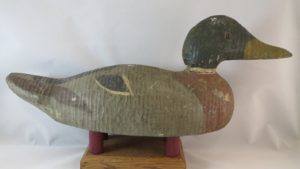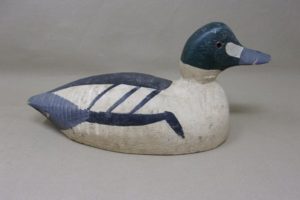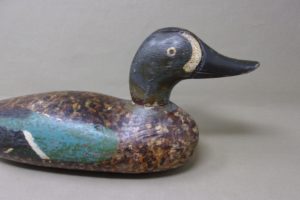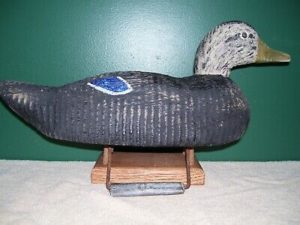A Decoy Corner Article
By Bruce Urben, WWA President

PADCO mallard
I was recently contacted by a reader of our Decoy Corner to help him identify his vintage wood decoy. After reviewing the photos he sent, it was pretty easy to determine that his decoy was classified as a “factory” decoy. What I mean by “factory” is a decoy that is produced almost entirely by a duplicating lathe from a model body and head. The majority of wood decoys sold in the 1930’s-1940’s were made by “factory” decoy makers. There or four manufacturers produced the majority of these decoys and distributed them nationwide. Mason decoys, Animal Trap decoys and Pascagoula Decoy Company (PADCO) were several that produced tens of thousands of decoys for the waterfowler.
When I was researching the decoy from this reader, I looked at one of the major “factory” decoy manufacturers that I hadn’t highlighted before in this Decoy Corner. Considering their output, it would not be uncommon to find these vintage decoys at antique shops, rummage sales or local auctions. Here is the story of Pascagoula Decoy Company (PADCO):

PADCO drake goldeneye
The PADCO decoy company was actively producing decoys from 1941-1960. They were formed in 1941 by owners L.C. Winterton and C.L. Dees. In just several years PADCO would grow into a major decoy maker in Mississippi and, interestingly enough, the only decoy factory not to be acquired by Victor/Animal Trap Co., which was also located in Pascagoula, MS.
PADCO operated on Magnolia Street in Pascagoula from 1941 to 1960, at which time they changed their name to Singing River Decoy Co. The company ceased all operations by 1970.
PADCO sold four different models of decoys; all were differentiated by quality, their paint scheme and weight. Their lightest turned bodies with no imperfections in the wood were highly sanded and called “supreme” models. Heavier bodies with imperfections were graded into three lower models, all of which were un-sanded off the lathe: Top flight, Standard and Special grades. These three models had a descending level of paint detail as well. To the layman it is very difficult to differentiate between these three models as all of them have very distinct lathe knife marks on the body and head. Their advertising calls it “feathering”. All PADCO decoys were made of solid wood and were made of tupelo gum or pop ash, which was quite available in Mississippi.

PADCO ring-necked hen
Some identifying traits of PADCO decoys include:
- A triangular wing patch when included in the species;
- A slightly upturned head;
- A breast that is full and has a large full shoulder area; and
- All are made of solid wood, no hollowing.
According to the PADCO sales brochure, they produced mallard, pintail, redhead, ring-neck, black duck, bluebill, canvasback, goldeneye and wedge on decoys. Mallard was the most highly produced species.

PADCO black duck
While most “factory” decoys are not highly collectible as of yet, there is no question in my mind that they will be in the future.
Warman’s Duck Decoys, by Russell E. Lewis (2006) values these decoys at $40-$200 for excellent condition examples and less produced species. While these decoys were not produced individually by hand with a carving knife, drawknife or rasp, these 80-year-old decoys served a purpose for waterfowlers all over the country. And, they are still a nice looking decoy on the mantle! If only they could talk and tell you where they were used for the last 70 years!
